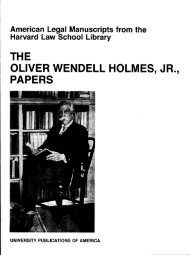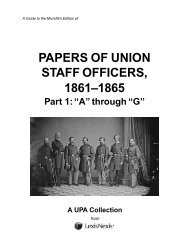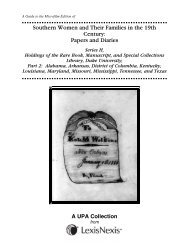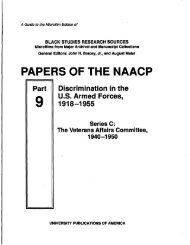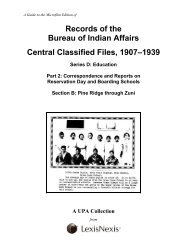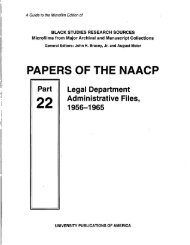Records of ante-bellum southern plantations - LexisNexis
Records of ante-bellum southern plantations - LexisNexis
Records of ante-bellum southern plantations - LexisNexis
You also want an ePaper? Increase the reach of your titles
YUMPU automatically turns print PDFs into web optimized ePapers that Google loves.
INTRODUCTION<br />
The impact <strong>of</strong> the <strong>ante</strong>-<strong>bellum</strong> <strong>southern</strong> <strong>plantations</strong> on the lives <strong>of</strong> their black and white<br />
inhabitants, as well as on the political, economic, and cultural life <strong>of</strong> the South as a whole, is one<br />
<strong>of</strong> the most fascinating and controversial problems <strong>of</strong> present-day American historical research.<br />
Depending upon the labor <strong>of</strong> slaves who constituted the great majority <strong>of</strong> the American black<br />
population, the <strong>plantations</strong> were both homes and business enterprises for a white, <strong>southern</strong> elite.<br />
They were the largest, the most commercialized, and on the whole, the most efficient and<br />
specialized agricultural enterprises <strong>of</strong> their day, producing the bulk <strong>of</strong> the South’s staple crops <strong>of</strong><br />
tobacco, cotton, sugar, rice, and hemp. Their proprietors were entrepreneurs who aspired to and<br />
sometimes, after a generation or two, achieved the status <strong>of</strong> a cultivated landed aristocracy.<br />
Many distinguished themselves not only in agriculture but in the pr<strong>of</strong>essions, in the military, in<br />
government service, and in scientific and cultural endeavors.<br />
Pl<strong>ante</strong>rs ambitious to augment their wealth, together with their black slaves, were an important<br />
driving force in the economic and political development <strong>of</strong> new territories and states in the<br />
Southwest. Their commodities accounted for more than half the nation’s exports, and the<br />
<strong>plantations</strong> themselves were important markets for the products <strong>of</strong> northern industry. In short,<br />
they played a crucial role in the development <strong>of</strong> a national market economy.<br />
The <strong>plantations</strong> <strong>of</strong> the Old South, the white families who owned, operated, and lived on them,<br />
and the blacks who toiled on them as slaves for more than two centuries, have been the subjects<br />
<strong>of</strong> numerous historical studies since the pioneering work <strong>of</strong> Ulrich B. Phillips in the early twentieth<br />
century. The literature, highly controversial, has focused on questions such as the evolution and<br />
nature <strong>of</strong> the pl<strong>ante</strong>r class and its role in shaping the white South’s economy, culture, and values;<br />
the conditions experienced by American blacks in slavery; the impact <strong>of</strong> the “peculiar institution”<br />
on their personalities and the degree to which a distinct Afro-American culture developed among<br />
them; and, finally, the sources <strong>of</strong> the tension between the proslavery interests <strong>of</strong> the South and<br />
the “free labor” interests <strong>of</strong> the North that culminated in secession and civil war.<br />
Research materials are plentiful. Census returns and other government documents, newspapers<br />
and periodicals, travelers’ accounts, memoirs and autobiographies, and an abundance <strong>of</strong><br />
polemical literature have much to tell historians about life on <strong>ante</strong>-<strong>bellum</strong> <strong>plantations</strong>. The<br />
autobiographies <strong>of</strong> former slaves, several twentieth-century oral history collections, and a rich<br />
record <strong>of</strong> songs and folklore are significant sources for the black experience in slavery. All the<br />
historical literature, however, from Phillips to the most recent studies, has relied heavily on the<br />
enormous collections <strong>of</strong> manuscript plantation records that survive in research libraries scattered<br />
throughout the South. These manuscripts consist <strong>of</strong> business records, account books, slave lists,<br />
overseers’ reports, diaries, private letters exchanged among family members and friends, and<br />
even an occasional letter written by a literate slave. They come mostly from the larger tobacco,<br />
cotton, sugar, and rice <strong>plantations</strong>, but a significant number survive from the more modest estates<br />
and smaller slaveholdings whose economic operations tended to be less specialized.<br />
Plantation records illuminate nearly every aspect <strong>of</strong> plantation life. Not only business<br />
operations and day-to-day labor routines, but family affairs, the roles <strong>of</strong> women, racial attitudes,<br />
relations between masters and slaves, social and cultural life, the values shared by members <strong>of</strong><br />
the pl<strong>ante</strong>r class, and the tensions and anxieties that were inseparable from a slave society all<br />
are revealed with a fullness and candor unmatched by any <strong>of</strong> the other available sources.<br />
Moreover, these records are immensely valuable for studies <strong>of</strong> black slavery. Needless to say,<br />
since they were compiled by members <strong>of</strong> the white master class, they provide little direct<br />
v



